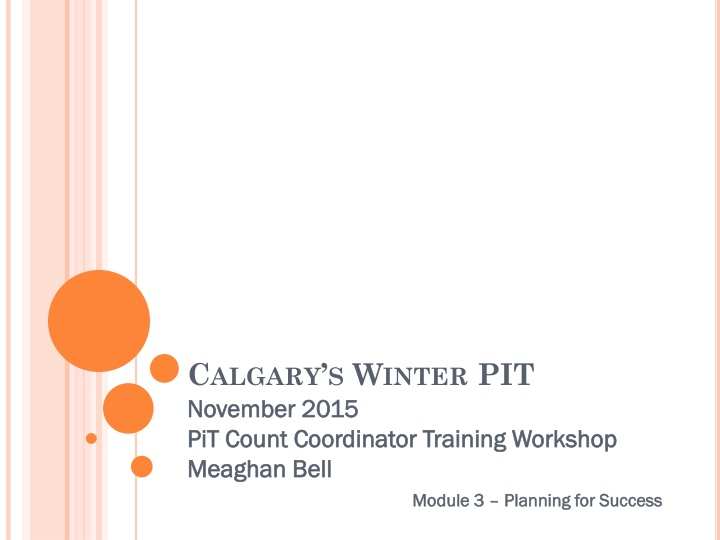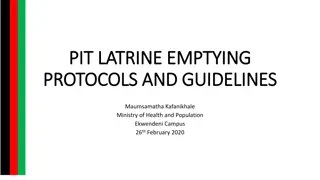CALGARY’S WINTER PIT
This workshop, led by Meaghan Bell, focuses on preparing PIT coordinators in Calgary for a successful program in November 2015. Module 3 delves into strategic planning techniques to enhance coordination efforts and ensure a successful event. Participants will learn crucial skills to effectively manage and supervise PIT counts, making a positive impact in their community.
Download Presentation

Please find below an Image/Link to download the presentation.
The content on the website is provided AS IS for your information and personal use only. It may not be sold, licensed, or shared on other websites without obtaining consent from the author.If you encounter any issues during the download, it is possible that the publisher has removed the file from their server.
You are allowed to download the files provided on this website for personal or commercial use, subject to the condition that they are used lawfully. All files are the property of their respective owners.
The content on the website is provided AS IS for your information and personal use only. It may not be sold, licensed, or shared on other websites without obtaining consent from the author.
E N D
Presentation Transcript
CALGARYS WINTER PIT November 2015 November 2015 PiT PiT Count Coordinator Training Workshop Count Coordinator Training Workshop Meaghan Bell Meaghan Bell Module 3 Module 3 Planning for Success Planning for Success
BACKGROUND Calgary s PiT occurred biannually in May between 1992-2008 coordinated by City of Calgary 2012 CHF took over role of coordination, undertook international review of PiT methodologies Decision to align with HUD for January Count Assumption: shelter and facility counts would be more accurate as shelter stayers return to the shelters earlier to secure their spot cold temperatures would bring rough sleepers inside
WINTER 2012 COUNT Planning: Consultation with outreach teams, CPS, Calgary bylaw services to identify active camps Assessing occupancy at emergency shelters Outreach to local businesses for donations and supplies (sleeping bags, jackets, hand warmers) Communication to volunteers re: weather updates, appropriate dress and weather exposure
WEEKOF JANUARY 18, 2012 Extreme cold weather temperatures around -35 Exploring conditions for which PiT would be cancelled with partners (Calgary Police and outreach teams) Tracking shelter utilization and assessing number of potential beds for transport night of the count and planning for people who were barred from shelters Logistics: recruiting additional volunteers and vehicles Re-arranging teams Swapping pens for pencils for street surveys
NIGHTOFTHECOUNT Count went on, 10 p.m. -1 a.m -37 160 volunteers Every team had a vehicle to drive to their zones All volunteer teams were in the inner city and encouraged to go into open businesses (Tim Horton s, McDonalds, to warm up) Transportation crews available for people encountered who wanted to go to a shelter
WINTERCOUNTSTRENGTHS Drew attention to emergency planning Volunteer enthusiasm Community awareness (volunteers, interactions night of, local businesses, media) Engagement with most entrenched rough sleepers Equity in how, and who was approached the night of the count
SHELTERFROMTHESTORM when overnight temperatures fall to extreme levels, the number of rough sleepers who have moved into shelters is equal to 7% of the average number of overnight shelter stays winter temperatures between 0 C and -10 C and precipitation has a particularly strong effect on moving rough sleepers indoors. Those conditions have have caused movements of rough sleepers into shelters; a temporary but unexpected inflow equal to 10-15% of the average number of shelter users Kneebone, 2014. http://policyschool.ucalgary.ca/sites/default/files/r esearch/weather-and-homeless-kneebone- jadidzadeh.pdf

 undefined
undefined












































